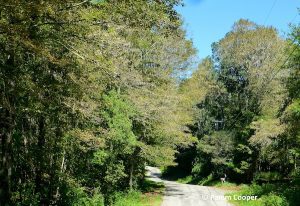 This summer has been one for the books, at least weather-wise. It has been rainy with little periods of dry weather, and the warm nights coupled with high humidity have provided an excellent opportunity for certain fungal pathogens to develop. Anthracnose species are just some of the fungal diseases that affect many plants, especially those under stress, and certain maples were infected earlier this season.
This summer has been one for the books, at least weather-wise. It has been rainy with little periods of dry weather, and the warm nights coupled with high humidity have provided an excellent opportunity for certain fungal pathogens to develop. Anthracnose species are just some of the fungal diseases that affect many plants, especially those under stress, and certain maples were infected earlier this season.
Driving along the road, maples infected with anthracnose can be clearly seen. The foliage has turned brown, leaves appear to be drying up, and leaf fall may be extensive. On some trees, it appears as though only seed clusters remain on the trees while leaves are almost all on the ground. This premature leaf drop may affect the tree’s ability to manufacture carbohydrates for next spring’s growth spurt. When leaf fall occurs early enough in the year then trees can produce new leaves before fall so this is not an issue. Leaf drop began on many trees in August, so time will tell what lingering effect this will have on some maples.
All maples including sugar maples (Acer saccharum), Norway maples (A. platanoides), red maples (A. rubrum), and others are susceptible to infection from anthracnose when environmental conditions, host pathogens, and a susceptible host plant combine to make a perfect storm for disease development. While normally a minor disease of maples, environmental conditions that promote disease infections that are persistent can be more than just an aesthetic issue and be more serious on trees already weakened by other issues.
Anthracnose fungi overwinter within dead leaf tissue and in any infected twigs and buds. The fruiting bodies are produced in the spring from any leaves left on the ground or from the infected twigs and buds. The spores that are produced will be spread by splashing rainwater or wind. Spores are only produced when the environmental conditions are right – usually during periods of mild and wet weather that occur from spring into late summer. Typically, these spores are more numerous in late spring and early summer, as they were this year. During hot dry weather, spore activity is less, but we certainly did not experience these conditions this year.
What can a homeowner do if their trees have suffered from anthracnose this year? The easiest thing to do is rake up the leaves from infected trees and remove them from the property. If dumped in the woods, infections can occur on any trees near those leaves. Infected twigs can be pruned off, and discarded, but that is not practical for large trees. Get a soil test to determine if any nutritional deficiencies need correcting. A pH that is too acidic can be raised by liming correctly based on soil test results. Maples can struggle in soils where the soil pH is too low. Sometimes repeat limestone applications are needed.
Do your best to make sure the growing conditions you can control like compaction issues, fertilization needs, problems with flooding, infected leaf pick up, and other things that may affect tree health are taken care of. Next year may be the total opposite of this year and may or may not bring a different set of problems for maples. Anthracnose may not be a concern if we have a drier year, and that is what many of us homeowners and gardeners hope for – perhaps!
By Pamm Cooper, UConn Home and Garden Education Center
For questions on maple anthracnose or if you have any other gardening questions, contact the UConn Home & Garden Education at (877) 486-6271 or www.homegarden.cahnr,uconn.edu or your local Cooperative Extension Center.